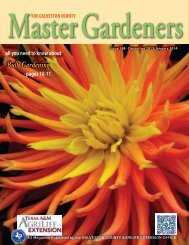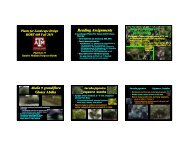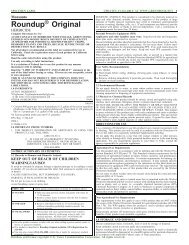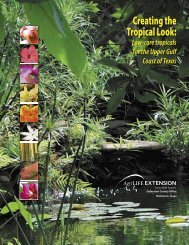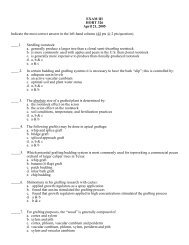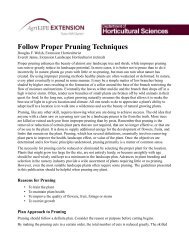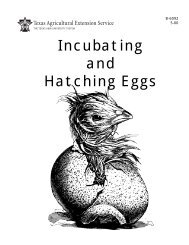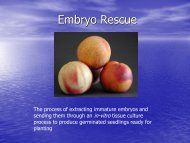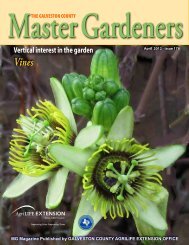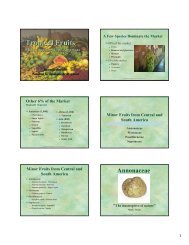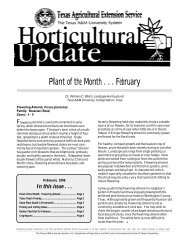C:\Mike's documents\book\Thirdedition\temp.wpd - Aggie Horticulture
C:\Mike's documents\book\Thirdedition\temp.wpd - Aggie Horticulture
C:\Mike's documents\book\Thirdedition\temp.wpd - Aggie Horticulture
You also want an ePaper? Increase the reach of your titles
YUMPU automatically turns print PDFs into web optimized ePapers that Google loves.
Myrospermum sousanum A.D. Salinas & M.C. JohnstonArroyo SweetwoodOther Common Names: Palo Judio, Palo Nuevo, Sweetwood.Family: Fabaceae (Leguminosae).Cold Hardiness: The useful range of this species has not been fully tested, but it appears to be usefulin at least USDA zones 8 to 10.Foliage: Alternate; deciduous; mostly odd, sometimes even, pinnately compound; 5O to 12O long; thetwelve to thirty seven leaflets have very short petiolules; leaflets are elliptic to obovate and ¾O to1¾O long; tips are obtuse to emarginate; bases are rounded to nearly acute; leaflets are glabrous withpinnate veins; the tiny deltoid stipules are shed early; petioles are ¼O to ½O long; the foliage has astrong smell reminiscent of raw peas; foliage is light to medium green in summer, sometimesdeveloping a golden yellow fall color, but the young foliage may be damaged by frost prior to coloringup.Flower: Small white pea-shaped flowers occur in axillary or terminal racemes of ten or more flowersin late spring to mid-summer; flowers have a mildly spicy cinnamon scent; trees are mildly showy inflower.Fruit: Fruits are small flattened brown pods containing one to three seeds; seeds are flattened disks dOto ½Olong.Stem / Bark: Stems — stems are a light green turning gray-green as they mature; numerous raised lighttan lenticels are present; crushed stems are said to smell of cinnamon and vanilla, but they smellmore like fresh peas to me; Buds — buds are gray-green and nearly embedded in the stems; Bark— the bark starts tan-gray then matures to a darker brown with vertical sinuous furrows.Habit: Trees are fast growing 10N to 20N (25N) tall large shrubs or small trees which develop irregularlyrounded crowns; plants usually have multiple stems unless trained to a single trunk; the overalltexture is medium in summer, medium-coarse in winter; there are unsubstantiated reports of someplants reaching 60N in height; the wood is sweetly scented, hence the name Sweetwood.Cultural Requirements: Although only planted at present in limited locations, M. sousanum appearsadapted to a variety of soil types as long as they are moderately well drained; trees grow and flowerbest in full sun; they are drought and heat tolerant once established; trees tolerate a range of soil pH,appearing to grow equally well in limestone based soils in the Hill Country and Dallas as in sandyacidic soils in East Texas; they require little care once established and are easily propagated fromseed.Pathological Problems: None are reported, but some may occur as this species is more widely grown.Ornamental Assets: Fragrant white flowers, yellow fall color, small size and ease of culture are theprimary assets.Limitations & Liabilities: None are of particular note; plants benefit from some initial training todevelop a good trunk character; the foliage grows late into the season and may be damaged by earlyfrosts.Landscape Utilization: This large shrub or small tree is suitable for naturalizing or transitionallandscapes in arid regions; if limbed up as a small tree, it might be suitable for sidewalk plantings,plaza areas, or in parking lot islands due to its tolerance of reflected heat.Other Comments: This species was first described in 1982; introduced to the Texas nursery trade bythe famous plantsman, Lynn Lowery; this is an interesting tree with some potential for those whoappreciate the unusual, but does not have sufficient ornamental assets to be a big seller in the trade.
Native Habitat: First described from specimens found along the Texas / Mexican border; it is not clearif any specimens have been found that are native to this side of the Rio Grande River, but it occursjust south of the river in Northern Mexico.Related Taxa: No cultivars are available at present.References: Ogden, 1992; Salinas and Johnston, 1984.Copyright 2005 with all rights reserved by Michael A. Arnold; intended for future inclusion in Landscape Plants For TexasAnd Environs, Fourth Edition.



